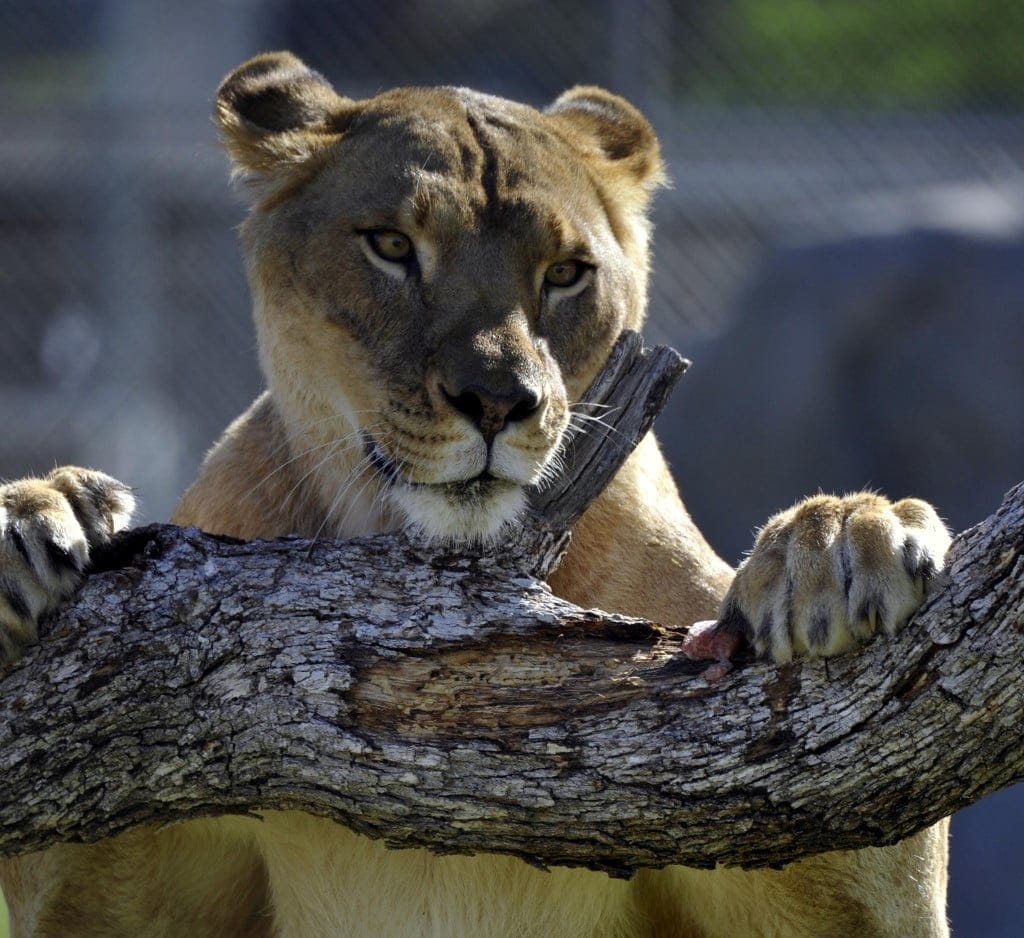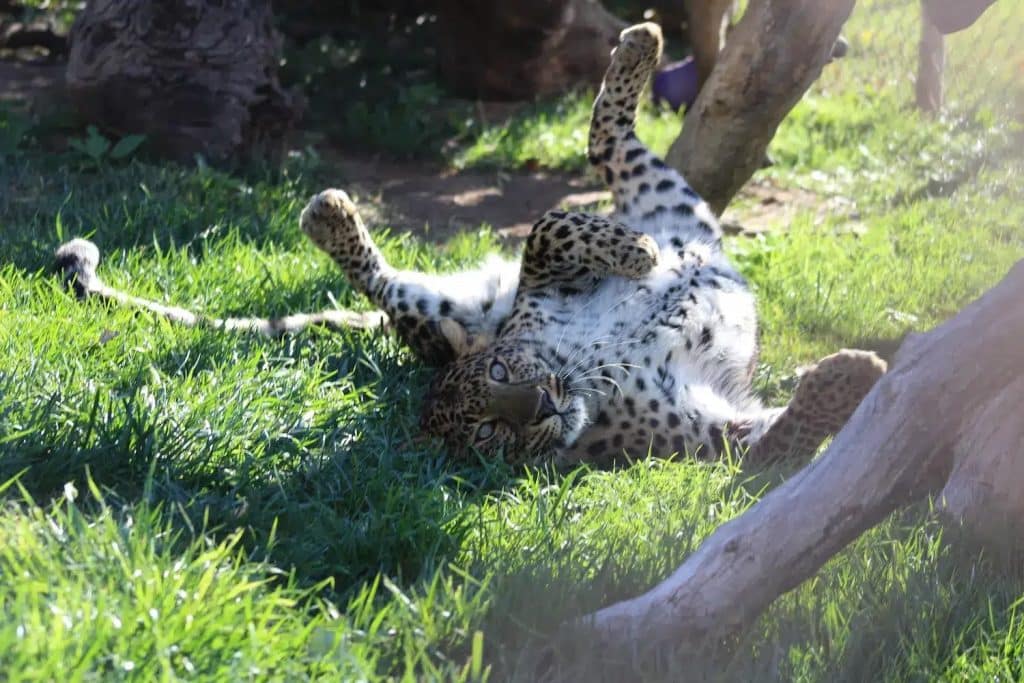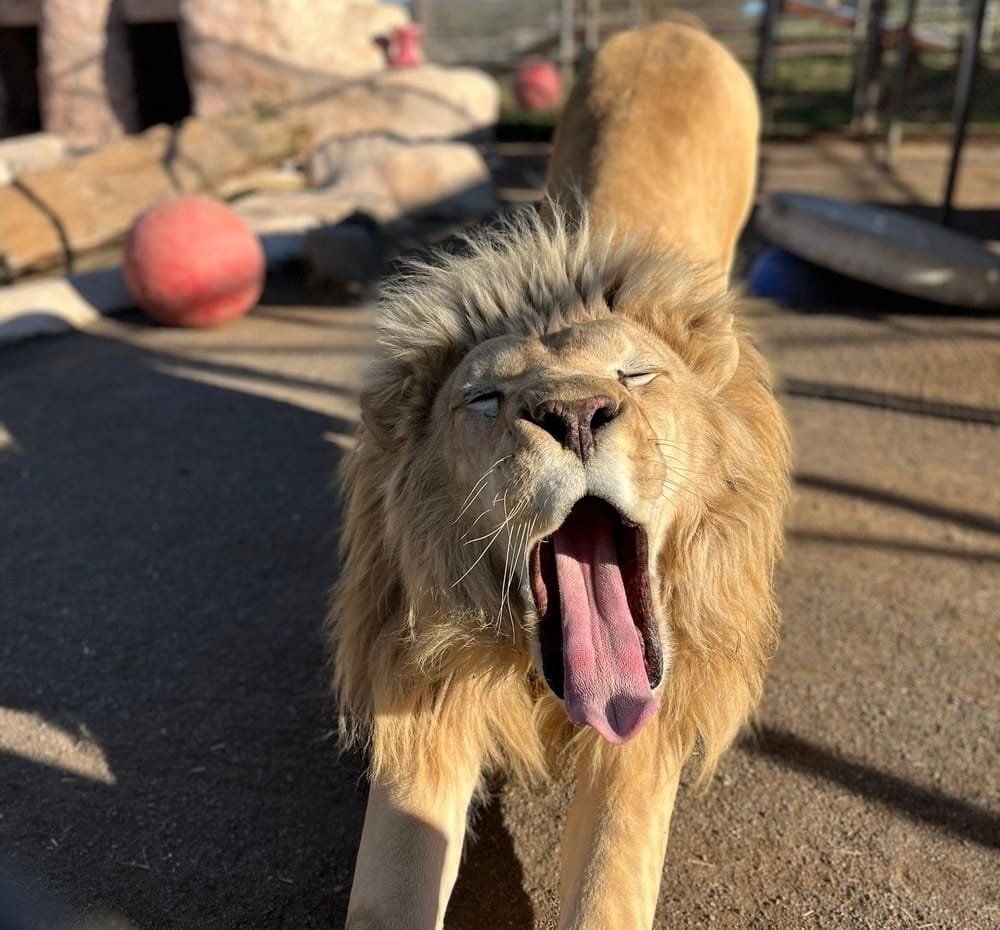

A lion’s roar is one of the most iconic sounds in the animal kingdom. Deep, powerful, and capable of traveling up to five miles across the savanna, it is a declaration of strength that commands attention. But while the roar of a male lion can stop us in our tracks, the real conversations between big cats often happen in much quieter ways.
A flick of the tail, a subtle shift in body posture, a low chuff of greeting, these are the messages that pass silently between lions, tigers, leopards, and other wild cats. They are signals that speak volumes about mood, territory, and health.
At Lions Tigers & Bears, a nonprofit big cat and accredited exotic animal sanctuary in Alpine, California, understanding these signals gives us a richer appreciation for the emotional lives of apex predators and reminds us just how much is being said beyond the roar.
Communication is the glue that holds the wild together. For big cats, it is the difference between conflict and cooperation, survival and danger.
As apex predators, these animals rely on a sophisticated blend of visual communication, body language, vocalizations, and scent marks to navigate their world. Communication helps them:
Some signals travel across long distances, such as a lion’s booming roar or the scent marks left on trees and grass. Others are reserved for close range, like the gentle chuff between adult tigers or the relaxed roll of a leopard basking in the sun.

Together, these languages form a silent code that ensures survival in environments where competition is fierce and misunderstandings can be deadly.
Big cats produce their famous roars thanks to unique adaptations in their vocal folds (sometimes called vocal cords). Unlike house cats, which purr continuously, lions and tigers have flattened vocal folds that allow them to produce deep, resonant sounds with less effort. This anatomical difference explains why tigers roar with a rumbling growl while lions produce earth-shaking, low-frequency calls.
A male lion’s roar is often a territorial broadcast, warning other lions to stay away. It’s also a way to keep pride members connected across vast distances. Conversely, Tigers use their roar to advertise their presence in dense forests where visibility is poor. While lions roar in groups, adult tigers usually roar alone, since they live solitary lives.
Female tigers also roar, but often at higher pitches than males, especially when calling to cubs. These high-pitched calls may travel less distance but carry tenderness and urgency that adult tigers understand instinctively.
Not all vocalizations are about intimidation. Big cats use a variety of softer sounds when interacting up close:
Every sound, from the loudest roar to the quietest hiss, is part of a complex system of long-distance communications and intimate exchanges that structure a big cat’s daily life.

If you’ve ever lived with a house cat, you already know how expressive they can be without making a sound. Wild cats are no different. Their body language and visual communication provide some of the clearest windows into their moods.
The way a big cat holds itself speaks volumes. A crouching tiger with muscles taut is ready to pounce. A lion stretched on its back, paws in the air, is signaling relaxation and comfort. These postures mirror many of the signals in domestic cats, reminding us of the deep evolutionary roots shared across species.
The tail is like an antenna of emotion. A slow, steady swish may signal irritation, while a playful flick suggests curiosity. Ears pressed flat against the head warn of aggression, while ears forward show attentiveness.
Snarling, baring teeth, or even subtle whisker movements convey everything from dominance to submission. Caregivers at sanctuaries rely heavily on these signals to know when to approach or give an animal space.
Big cats rarely waste energy on unnecessary fights. They mostly use body posture and visual communication to resolve tension and avoid conflict long before any claws or teeth are involved.
Perhaps the most overlooked language of big cats is the one carried on the wind: scent.
Lions, tigers, and leopards use scent marks as territorial billboards. They spray urine, rub their cheeks on trees, or claw bark to leave chemical messages that say, “This space is taken.” This process, known as scent marking, is critical for avoiding unnecessary conflict.
Big cats possess an extraordinary sense of smell, aided by a special organ called the Jacobson’s organ, located on the roof of the mouth. When a tiger curls its lips in a behavior called the flehmen response, it draws in scents to analyze them.
Scent also plays different roles depending on sex and life stage:
Scent is never just about space. It conveys layers of identity, who the cat is, its physical condition, its social rank, even its mood. For an animal navigating vast landscapes where visual or vocal signals may not always reach, this chemical language ensures that presence, intention, and status are clearly understood without a single sound.
For too long, big cats were seen as instinct-driven hunters. Today, research and observation show that they possess emotional lives as complex as those of many social mammals.

When lions groom one another or tigers chuff softly, these are emotional exchanges that reinforce bonds and signal trust. Rolling in the grass, relaxed breathing, or slow blinks are all ways big cats show contentment. These are their feel-good moments.
On the flip side, pacing, excessive grooming, or tail lashing are indicators of stress or frustration. Low growls or defensive postures reveal discomfort or unease.
Through these cues, caregivers and researchers gain insights into the mental well-being of big cats. It’s a reminder that behind the label of “apex predators” are individuals with rich emotional worlds of their own.
At accredited sanctuaries like Lions Tigers & Bears, every flick of an ear or shift in posture is information.
Decoding these signals allows caregivers to respond quickly, providing medical care or adjusting routines to reduce stress. More importantly, they build trust.
Trust is the cornerstone of working with wild cats. These animals may be used to long-distance communications in the wild, but in sanctuaries, close relationships matter. When caregivers respond consistently to body language and vocal signals, big cats learn that their needs will be respected. This mutual understanding keeps both animals and humans safe.
One of the most fascinating parts of studying wild cats is realizing how much they have in common with the cats in our living rooms.
The truth is, most people only think of big cats as fierce hunters or powerful symbols. But once you notice how they communicate, you realize there’s a whole world happening that we rarely get to see.
That’s why accredited sanctuaries like Lions Tigers & Bears matter. We give these animals a safe space to express that hidden language, and you the chance to witness it up close. When you stand just a few feet away from a tiger and hear a soft chuff, or catch the subtle swish of a lion’s tail, it will change how you see them forever.
If you’ve only ever thought of big cats by their roar, we invite you to see the rest of their story. Visit Lions Tigers & Bears, located just minutes from downtown San Diego. Spend time watching, listening, and simply being present, and you’ll walk away with a deeper respect for these animals than you could ever imagine.


Ph: 619.659.8078
Fx: 619.659.8841
[email protected]
24402 Martin Way, Alpine, CA 91901